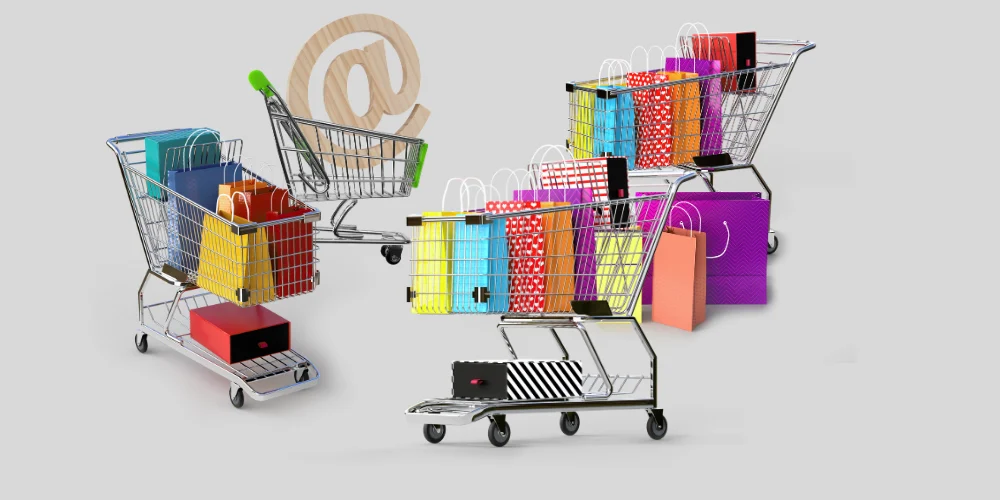Last Updated on 1 year ago by Ecem Ertürk
Abandoned cart emails are a crucial component of an email marketing strategy for boosting sales. They are sent to customers who have added items to their carts but have not completed their purchase. Abandoned cart emails aim to encourage these customers to return and complete their transaction. The e-commerce site design directly impacts the user experience, potentially reducing the abandonment rate of shopping carts. A well-designed e-commerce site facilitates the shopping process for customers, guiding them throughout the purchase journey. By implementing an effective abandoned cart email strategy, businesses can recover lost sales and convert hesitant prospects into paying customers.
The Impact of Abandoned Cart Emails on Sales Recovery
Abandoned cart emails have a significant impact on sales recovery. They are highly effective in converting lost business and turning hesitant prospects into customers. According to industry data, ecommerce brands lose billions of dollars in sales revenue annually due to cart abandonment. However, by leveraging abandoned cart emails, businesses can recover a substantial portion of these lost sales.
These emails have higher open rates compared to traditional marketing emails and can greatly increase conversion rates. By sending personalized and targeted messages to customers who have abandoned their carts, businesses can re-engage them and encourage them to complete their purchase. Additionally, abandoned cart emails provide an opportunity to offer incentives such as discounts or free shipping, creating an extra incentive for customers to return and make a purchase.
Identifying Common Reasons Behind Shopping Cart Abandonment
Understanding the common reasons why shoppers abandon their shopping carts is essential for developing an effective abandoned cart email strategy. By addressing these reasons in your abandoned cart emails, you can significantly increase the chances of recovering lost sales. Here are some of the common reasons for abandonment:
- Complicated checkout processes: A lengthy or confusing checkout process can frustrate customers and lead to cart abandonment. Simplify your checkout steps and minimize the required information to make it quick and easy for customers to complete their purchase.
- High shipping costs: When customers encounter unexpectedly high shipping costs, they may decide to abandon their carts. Consider offering free shipping or clearly communicate your shipping charges upfront to avoid any surprises.
- Better deals elsewhere: Customers may abandon their carts if they find better deals or discounts from competitors. Stay competitive by monitoring prices in the market and offering attractive promotions to entice customers to complete their purchase with you.
- Technical website problems: Glitches, errors, or slow load times on your website can deter customers from completing their purchases. Regularly monitor and optimize your website’s performance to ensure a smooth and seamless shopping experience.
- Customers not ready to make a purchase: Some customers may add items to their carts to compare prices, gather information, or simply browse. They may not be ready or willing to make a purchase at that moment. To encourage these customers to return, consider sending targeted follow-up emails highlighting the value and benefits of the abandoned products.
By addressing these common reasons for abandonment in your abandoned cart email campaigns, you can effectively engage with customers and increase the chances of recovering lost sales. In the next section, we will explore these common reasons in more detail and provide insights on how to address them in your abandoned cart email strategy.
Implementing Abandoned Cart Email Sequences for Maximum Effect
The key to maximizing the effectiveness of abandoned cart email campaigns lies in implementing well-crafted email sequences. Rather than sending a single email, businesses can create a series of automated emails that are strategically designed to engage customers who have abandoned their carts. These email sequences can consist of reminders, follow-ups, and enticing promotional discounts, all aimed at increasing the chances of recovering those abandoned sales.
By sending multiple emails over a period of time, businesses can nurture the relationship with potential customers and provide them with the necessary incentives to return and complete their purchase. This approach allows for more touchpoints and further encourages customers to take action.
To ensure the maximum effect of abandoned cart email sequences, it’s important to follow best practices. One such practice is timing the emails appropriately. Sending the first email shortly after the cart abandonment occurs helps to maintain the customer’s interest. Subsequent emails can be sent with increasing intervals, reminding the customer of the abandoned cart and any time-sensitive promotions they may have missed out on. The goal is to strike a balance between being informative and persuasive without overwhelming or annoying the customer.
In addition to timing, the content of the emails should be carefully crafted to engage the customer and encourage them to take action. Personalization is key in abandoned cart email sequences. Addressing the customer by name and referencing the specific items they left in their cart creates a personalized experience and reinforces their interest in those products. Including customer reviews or social proof can further enhance the credibility of the emails and encourage trust in the brand.
Furthermore, including a clear call-to-action button that directs the customer back to their abandoned cart is essential. Making it easy for customers to complete their purchase is crucial for minimizing any friction in the buying process.
By implementing abandoned cart email sequences for maximum effect, businesses can significantly increase their chances of recovering abandoned sales and converting hesitant prospects into satisfied customers. The strategic combination of timing, personalized content, and compelling offers makes these email sequences a powerful tool in the arsenal of any email marketer.
Exploring the Essential Elements of a Successful Abandoned Cart Email

When it comes to recovering lost sales through abandoned cart emails, certain elements are essential for achieving success. These elements work together to engage customers and entice them to complete their purchase. By incorporating these key components into your email campaigns, you can increase the effectiveness of your abandoned cart recovery strategy.
A Snappy Subject Line
The subject line of your abandoned cart email is the first thing that customers see in their inbox. It should be attention-grabbing, enticing recipients to open the email and discover what’s inside. A compelling subject line can significantly increase the open rates of your emails and pique the interest of potential customers.
Personalized Introduction Text
Addressing the recipient by name and personalizing the introduction text creates a sense of connection and relevance. By tailoring your message to each individual customer, you can establish a personal relationship and increase the chances of re-engaging them. Personalization also helps to build trust and credibility, making customers more likely to consider completing their purchase.
Clear Display of Items Left in the Cart
When customers receive an abandoned cart email, it’s crucial to remind them of the specific items they left behind. This clear display of the abandoned items serves as a gentle nudge to remind customers of their initial interest and can jog their memory about the products they were considering. Including images, descriptions, and prices can further enhance the visual appeal and effectiveness of this reminder.
An Offer or Discount
A compelling offer or discount can be a powerful motivator for customers to complete their purchase. By providing an incentive, such as a limited-time discount or free shipping, you can overcome any hesitations or objections customers may have and encourage them to take action. Make sure to clearly communicate the value of the offer and highlight any exclusive benefits or savings.
A Prominent Checkout Button or Call-to-Action
The checkout button or call-to-action (CTA) in your abandoned cart email should be visually prominent and easy to click. The CTA should clearly communicate the next step for the customer, whether it’s returning to their cart or completing the purchase directly. Using contrasting colors, larger font sizes, and strategic placement can help draw attention to the CTA and increase the likelihood of conversion.
Reviews or Social Proof
Adding reviews or social proof to your abandoned cart email can help alleviate any doubts or concerns customers may have. By including positive testimonials or ratings from satisfied customers, you can reinforce the credibility and desirability of your products. Social proof creates a sense of trust and reassurance, making customers more inclined to move forward with their purchase.
Closing Text
The closing text is your opportunity to leave customers with a final impression and call-to-action. Whether it’s a friendly farewell, a reminder of the limited-time offer, or an invitation for further assistance, the closing text should serve as a compelling conclusion to your abandoned cart email. It’s important to end on a positive note and provide clear guidance on what customers should do next.
By incorporating these essential elements into your abandoned cart email campaigns, you can create compelling and persuasive messages that drive conversions and recover lost sales. Each element plays a crucial role in engaging customers and enticing them to complete their purchase, increasing the effectiveness of your abandoned cart recovery strategy.
Personalization: Crafting Targeted Messages to Re-engage Shoppers

Personalization plays a pivotal role in the success of abandoned cart email campaigns. By crafting targeted messages that are tailored to the individual shopper, businesses can greatly enhance their chances of re-engaging customers and recovering lost sales.
One effective way to personalize abandoned cart emails is by referencing the specific product or service that was left in the cart. By reminding the shopper of the item they were interested in, businesses can reignite their desire to make the purchase. This could be done by including a visual image of the product or by mentioning its unique features and benefits.
Another important aspect of personalization is addressing the shopper’s objections. By understanding the reasons why they abandoned their cart, businesses can create email content that directly addresses those concerns. For example, if high shipping costs were the reason for abandonment, the email could include a discount on shipping or offer alternative free shipping options.
Highlighting value propositions that resonate with the individual customer is also crucial for personalization. By identifying their preferences and needs, businesses can tailor their email content to showcase the specific benefits of completing the purchase. This could include highlighting customer reviews or testimonials that affirm the quality and satisfaction of the product.
The Role of Mobile Optimization in Abandoned Cart Email Strategy
Mobile optimization plays a crucial role in maximizing the effectiveness of an abandoned cart email strategy. With the exponential growth in mobile devices for online shopping, businesses must ensure that their abandoned cart emails are optimized for mobile viewing. Neglecting mobile optimization can result in a poor user experience and diminish the chances of recovering abandoned sales.
When optimizing emails for mobile devices, businesses should focus on creating responsive email designs that adapt to different screen sizes. This ensures that the email content is displayed correctly and legibly across various devices. Additionally, using mobile-friendly layouts that prioritize important information and minimize scrolling can enhance the overall user experience.
Another critical aspect of mobile optimization is ensuring that call-to-action buttons are easily clickable on mobile screens. The buttons should be large enough and have ample spacing to prevent accidental clicks. Additionally, businesses should consider using clear and concise copy that clearly states the intended action for the user.
By investing in mobile optimization, businesses can significantly increase the chances of engaging mobile shoppers and recovering abandoned sales. It is essential to stay updated with the latest mobile design and usability best practices to ensure that abandoned cart emails deliver a seamless and compelling experience across various devices.
Analyzing Top-Tier Abandoned Cart Email Examples for Inspiration
When it comes to creating effective abandoned cart email campaigns, studying successful examples from reputable brands can provide valuable inspiration and insights. By analyzing top-tier abandoned cart email examples, businesses can learn best practices, innovative strategies, and creative approaches to craft compelling emails that drive conversions.
In this section, we will take a closer look at several outstanding abandoned cart email examples and highlight their standout features. These examples showcase the power of personalized messaging, enticing offers, and engaging visuals to re-engage shoppers and drive them back to complete their purchase.
One remarkable example is the abandoned cart email from Nike. They skillfully use dynamic imagery that displays the abandoned items in the cart, along with a clear call-to-action that directs the shopper back to their website. The email also includes a personalized message addressing the shopper by their first name, creating a sense of familiarity and making the email feel more personal.
Another brand that excels in abandoned cart email campaigns is Amazon. Their emails showcase the power of social proof by including customer reviews and ratings for the abandoned items. This builds trust and confidence in the shopper, making them more likely to complete the purchase. Amazon also utilizes scarcity tactics by mentioning limited stock availability, creating a sense of urgency that motivates the shopper to take action.












